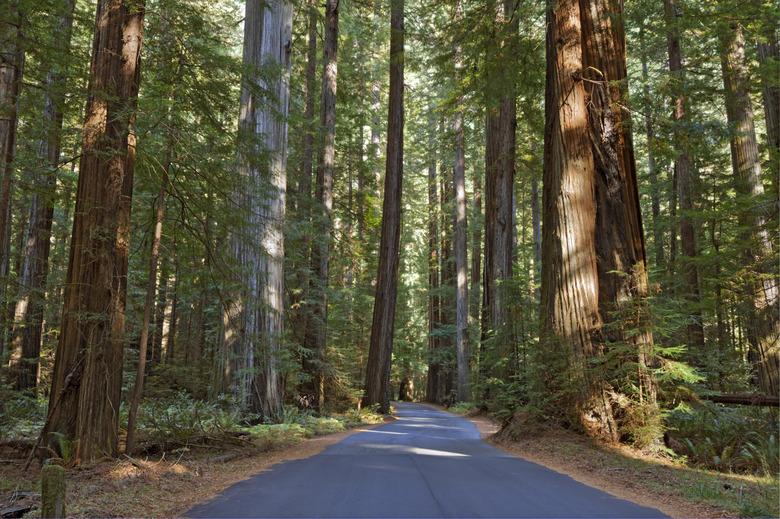How To Plant And Grow A Sequoia Seedling
Sequoia (Sequoia sempervirens) seedlings may be available as 1- to 2-gallon size nursery plants, or you can grow your own from seed. For such a large tree, reaching heights to 360 feet tall and 65 feet wide in nature, sequoia has small, light seeds. Although only around 15 percent of sequoia seeds are viable, sound seed germinates well. Sequoia, also called redwood or coast redwood, is suitable as a screen, street tree or specimen, and grows in U.S. Department of Agriculture plant hardiness zones 7 through 9. Planting and growing instructions for giant redwood (Sequoia gigantea) which grows in USDA zones 5 through 8, are similar.
Germinating Seeds
Plant the seeds soon after they're harvested. The seeds don't need pretreatment to germinate. Sow them 1 inch apart in 3-inch-deep, clean nursery flats with drainage holes in the bottom. Fill the flats with a mixture of equal parts peat moss and perlite. Cover the seeds with about 1/4 inch of potting mix, tamp it gently and water thoroughly. Place the flat in bright indirect light or partial shade and keep the potting mix moist but not soggy.
Transplanting Seedlings
After germination, continue to keep the potting mix moist because sequoia seedlings don't have root hairs and are vulnerable to drying out. Allow the seedlings to grow large enough to handle. Remove them from the seedling flat and transplant them into a 6-inch, clean pot that has drainage holes. Use a commercial soilless potting mix. Water the pot until water comes through the drainage holes. Continue the sequoia seedlings watering regularly. After about a month, gradually expose the seedlings to more sun each day until they are used to full sun. It should take about two weeks to complete this.
Soil and Spacing
A sequoia prefers rich, moist, well-drained soils rich in organic matter and doesn't tolerate dry soil. A sequoia grow best in areas with cool summers and mild winters. With good conditions, sequoias grow quickly, often growing 3 to 5 feet in a year. Space the seedlings according to how you'll use them in your yard. For specimen trees, space them about 30 feet apart because they'll only grow 60 to 100 feet tall and 15 to 25 feet wide in a yard. If you're using them as a hedge or screen, space them more closely, 6 to 10 feet apart, depending on how quickly you want them to fill in. Plant sequoias in full sun.
Planting Depth and Hole Size
When your seedling has filled out the 6-inch pot with roots going through the entire potting mix, plant it in the ground. In mild winter climates, January is a favorable planting time. Otherwise, plant in spring after danger of frost has passed. Dig a hole slightly larger than the root ball size. Tap the seedling out of the pot, taking care to disturb the root ball as little as possible. Place the seedling in the planting hole so the top of its soil is level with the soil of the planting site. Build a berm to make a watering basin. Take soil from another garden area and make a raised ridge about 2 feet wide with the tree in the center. Water the tree thoroughly.
Water and Fertilizer
Throughout the life of the sequoia, water the tree regularly. Apply enough water to carry past the root zone. Use a soil probe to assess the moisture condition of the soil, if necessary. Sequoias have shallow root systems, usually only in the top 3 to 4 feet of soil, so they are vulnerable to drying out. In large trees, the roots can spread to more than 100 feet away, so extend the watering basin beyond the drip line of the tree as it grows. Apply a 6-inch-deep layer of organic mulch, such as straw or grass clippings, over the entire root zone of the tree, keeping it away from the tree trunk. Apply a fertilizer, such as controlled-release 15-9-12, once a year in January at the rate of 1 1/3 pounds per 100 square feet. Spread the fertilizer then water it in well. Cover young trees when frost is predicted.
References
- Plants for a Future: Sequoia Sempervirens – (D. Don.) Endl.
- U.S. Forest Service: Sequoia Sempervirens (D. Don) Endl. Redwood
- University of Florida IFAS Extension: Sequoia Sempervirens Coast Redwood
- Missouri Botanical Garden: Sequoia Sempervirens
- Floridata: Sequoia Sempervirens
- University of California Davis Arboretum: Should I Grow a Redwood?
- California Native Gardening; Helen Popper
- Tree Planters' Notes: Seed Germination of Giant Sequoia
- Giant-Sequoia.com: Giant Sequoia Landscape Questions
